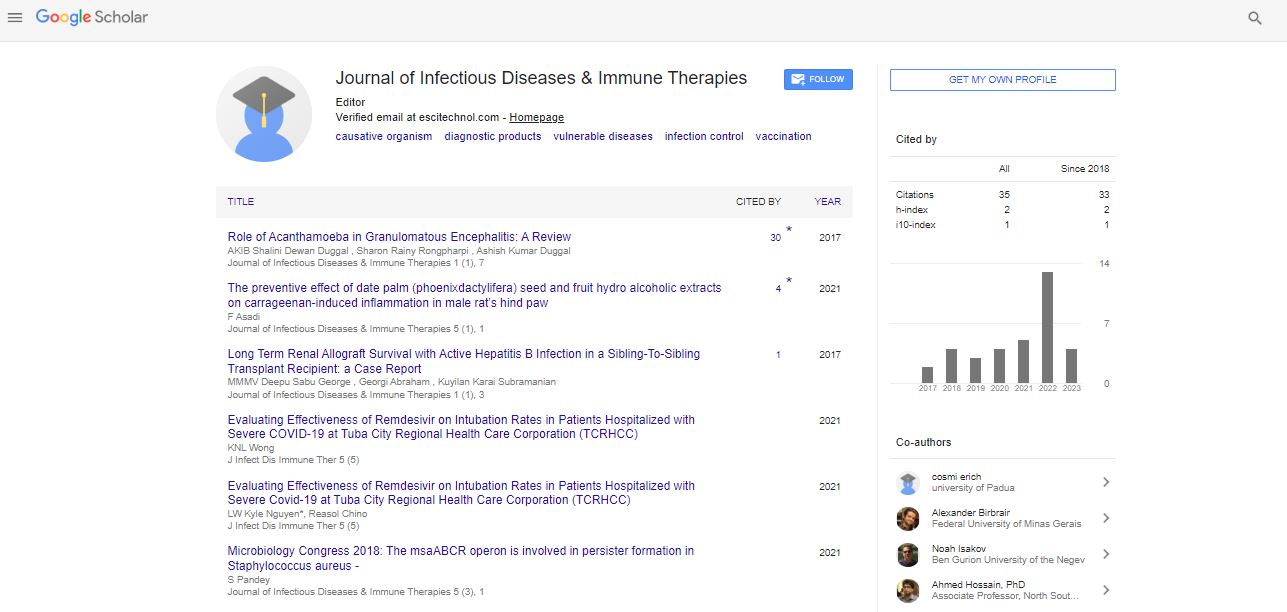Perspective, Jbmt Vol: 6 Issue: 2
Treatment of Hepatitis E Virus Infection
Garnacho Montero*
Division of Infectious Diseases, American University of Beirut Medical Center, Beirut, Lebanon
*Corresponding Author:Garnacho Montero
Division of Infectious Diseases, American University of Beirut Medical Center,Beirut, Lebanon
Email: garnachomontero@gmail.com
Received date: 02 March, 2022; Manuscript No. JIDITH-22-57255;
Editor assigned date: 04 March, 2022; PreQC No. JIDITH-22-57255(PQ);
Reviewed date: 15 March, 2022; QC No JIDITH-22-57255;
Revised date: 25 March, 2022; Manuscript No. JIDITH-22-57255(R);
Published date: 01 April, 2022; DOI: 10.4172/jidith.1000142.
Citation: Montero G (2022) Treatment of Hepatitis E Virus Infection. J Infect Dis Immune Ther 6:2
Keywords: Hepatitis E Virus; Infection
Introduction
Hepatitis E Virus (HEV)-induced acute hepatitis is widespread in impoverished nations and appears to be an emerging problem in developed countries. Anti-HEV IgG antibodies have been found in 6% to 16% of renal transplant recipients in seroprevalence investigations. Among cases of severe hepatitis in solid-organ transplant recipients, this hepatotoxic RNA virus is frequently overlooked or not routinely sought. Only three cases of acute HEV infection in organ transplant patients have been recorded. Despite the fact that two cases of persistent HEV infection have been described, HEV is thought to be the cause of acute hepatitis that does not progress to chronic hepatitis. HEV infection is spread by the feces–oral pathway and is considered a zoonosis in developed countries. It has a 1% mortality rate in the general population and a 30% mortality rate in pregnant women. Although HEV-induced acute hepatitis may be fulminant, no cases of chronic hepatitis have been described previously. The discovery of a large number of cases of acute HEV hepatitis in nonimmune compromised patients in southwest France motivated us to seek for HEV in solid-organ transplant recipients with unexplained hepatitis. Eight of the 14 patients with acute HEV infection who were studied here developed chronic hepatitis.
Hepatitis E Virus
The serum of 14 patients, none of whom had been outside of France in the previous year, was found to be positive for HEV RNA after all other causes of hepatitis had been ruled out. We were unable to locate any potential sources of contamination. Peak aminotransferase levels were lower in immuno compromised individuals than in non-immuno compromised patients. Histologic lesions (mostly patchy lobular necrosis) typical of classic acute viral hepatitis were observed; however, these lesions were milder than those reported in non-immuno compromised patients. These findings could be linked to transplant patients' immunosuppressive medication. Six of the 14 individuals with HEV infection recovered within six months of the end of the acute phase. In eight patients, however, HEV infection progressed to chronic hepatitis, as evidenced by consistently increased liver enzyme levels and detectable serum HEV RNA 15 months (range, 10 to 24) after the acute phase ended. A median of 12.5 months (range, 10 to 18) following the acute phase, liver biopsies revealed evidence of persistent viral hepatitis.
The histologic abnormalities, which included a dense lymphocytic portal infiltration with persistent piecemeal necrosis, were comparable to those seen in hepatitis C virus-infected patients none of the patients received any type of treatment, including no antiviral medication. After the diagnosis of HEV, the immunosuppressive therapy was not changed. We only did close monitoring of liver-enzyme levels because there were no known therapy recommendations for patients infected with HEV. There were no significant changes in demographic or clinical aspects between patients with resolving HEV infection and those with chronic HEV infection, including therapy with immunosuppressive drugs before the acute phase. However, the patients' immunologic state may have had a role in the progression to chronic illness. The time from transplantation to infection development was much shorter in patients with chronic HEV infection, and as a result, total lymphocyte counts, CD2, CD3, and CD4 lymphocyte counts were significantly lower than in patients with HEV infection that resolved. As a result, both the T-cell and B-cell responses appear to play a role in HEV clearance. In patients with chronic infection, HEV sero conversion took longer than in those with resolving infection. This discrepancy could be due to mycophenolate therapy, mTOR inhibitors, or both reducing the humoral immune response.
These medicines are known to impair the cell cycle development and differentiation of human B lymphocytes, as well as decrease antibody production. Clearing HEV and preventing hepatitis both require a humeral immune response. Antibodies against the HEV capsid have been proven to protect people from hepatitis E, according to Bryan et al. Passive immune prophylaxis investigations in cynomolgus monkeys have proven that the HEV capsid antibody can protect people from HEV infection. A HEV recombinant protein vaccine has recently been discovered to be effective in preventing HEV infection. In order to assess the prevalence of chronic HEV infection in transplant recipients who live in places where the disease is not common, more research is needed. Patients could be offered HEV vaccination before or after organ transplantation. The efficacy of immunization in these populations, on the other hand, should be investigated. Finally, our findings imply that HEV should be considered a hepatitis etiologic agent in organ transplant recipients. At least in organ transplant patients, we've shown that HEV infection can progress to chronic hepatitis. To assess the outcome of HEV infection in organ transplant patients, a longer follow-up is required.
 Spanish
Spanish  Chinese
Chinese  Russian
Russian  German
German  French
French  Japanese
Japanese  Portuguese
Portuguese  Hindi
Hindi 